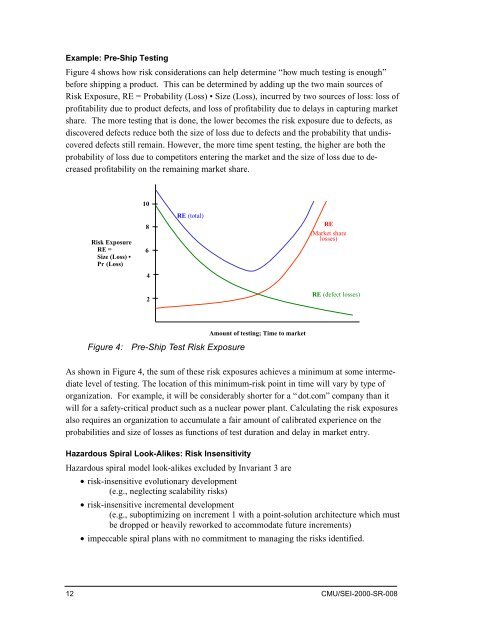00sr008
00sr008
00sr008
You also want an ePaper? Increase the reach of your titles
YUMPU automatically turns print PDFs into web optimized ePapers that Google loves.
Example: Pre-Ship Testing<br />
Figure 4 shows how risk considerations can help determine “how much testing is enough”<br />
before shipping a product. This can be determined by adding up the two main sources of<br />
Risk Exposure, RE = Probability (Loss) • Size (Loss), incurred by two sources of loss: loss of<br />
profitability due to product defects, and loss of profitability due to delays in capturing market<br />
share. The more testing that is done, the lower becomes the risk exposure due to defects, as<br />
discovered defects reduce both the size of loss due to defects and the probability that undiscovered<br />
defects still remain. However, the more time spent testing, the higher are both the<br />
probability of loss due to competitors entering the market and the size of loss due to decreased<br />
profitability on the remaining market share.<br />
10<br />
Risk Exposure<br />
RE =<br />
Size (Loss) •<br />
Pr (Loss)<br />
8<br />
6<br />
RE (total)<br />
RE<br />
(Market share<br />
losses)<br />
4<br />
2<br />
RE (defect losses)<br />
Amount of testing; Time to market<br />
Figure 4:<br />
Pre-Ship Test Risk Exposure<br />
As shown in Figure 4, the sum of these risk exposures achieves a minimum at some intermediate<br />
level of testing. The location of this minimum-risk point in time will vary by type of<br />
organization. For example, it will be considerably shorter for a “dot.com” company than it<br />
will for a safety-critical product such as a nuclear power plant. Calculating the risk exposures<br />
also requires an organization to accumulate a fair amount of calibrated experience on the<br />
probabilities and size of losses as functions of test duration and delay in market entry.<br />
Hazardous Spiral Look-Alikes: Risk Insensitivity<br />
Hazardous spiral model look-alikes excluded by Invariant 3 are<br />
•risk-insensitive evolutionary development<br />
(e.g., neglecting scalability risks)<br />
•risk-insensitive incremental development<br />
(e.g., suboptimizing on increment 1 with a point-solution architecture which must<br />
be dropped or heavily reworked to accommodate future increments)<br />
•impeccable spiral plans with no commitment to managing the risks identified.<br />
12 CMU/SEI-2000-SR-008














